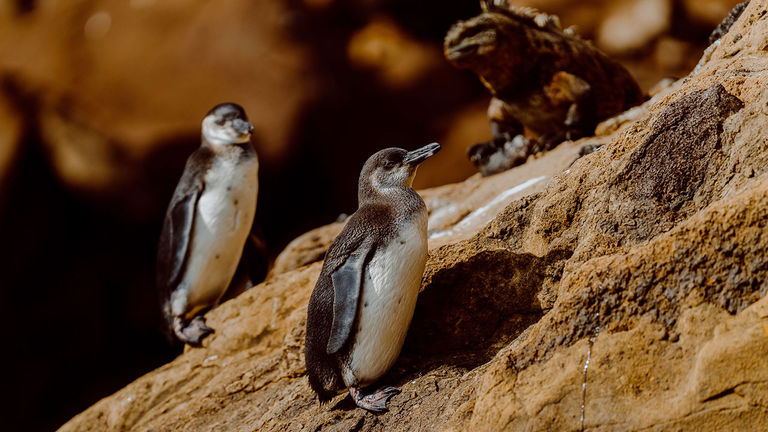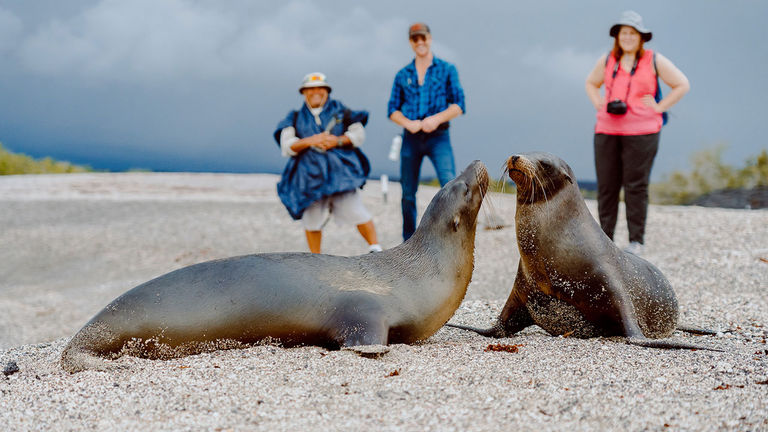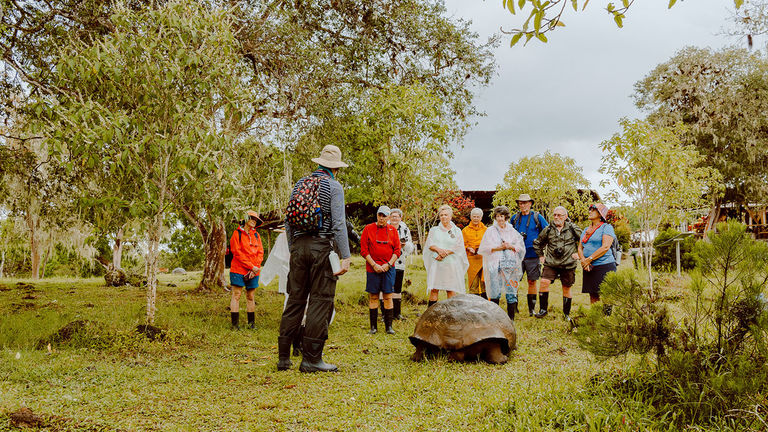In the time it took me to deplane in the Galapagos Islands and get onto my Hurtigruten Expeditions cruise ship, I had already seen an enormous land iguana at the airport, a handful of sleeping sea lions on the boat dock and a sea turtle swimming along the shoreline. I knew I was going to see a lot of wildlife in the Galapagos, but the reality of the experience was already blowing my high expectations out of the water.
This was a pattern throughout my sailing. I would cross my fingers, hoping to catch sight of a single Galapagos penguin (the only ones found north of the equator), and suddenly find myself bobbing in a Zodiac next to three of them, with another two on a nearby rock. I would fall asleep dreaming of seeing a marine iguana, and the next day be staring at hundreds of them mere feet away on a beach.
 Galapagos penguins are the only ones found north of the equator.
Galapagos penguins are the only ones found north of the equator.
Credit: 2023 Hurtigruten Expeditions
The Galapagos Islands is a relatively new destination offering for Hurtigruten Expeditions; the line only started sailing there in January 2022 on its nine-day Eastern Galapagos “In Darwin’s Footsteps” itinerary. In January of this year, it also launched a seven-day western loop (“Iconic Wildlife & Sublime Scenery”) and a seven-day Northern Galapagos trip (its “Nature and Wildlife Expedition Cruise”). Travelers can also combine the northern and western routes to take an extended 11-day “Nine of the Best Isles” itinerary.
The Western Galapagos Itinerary
In February, I sailed the new Western Galapagos itinerary, which includes two nights in Quito (with a day trip to Cotopaxi National Park) before a flight to the island of Baltra, where guests transfer to the Santa Cruz II for a four-night cruise. After quickly getting checked into my cabin, lunch was served while the ship transited to the north shore of Santa Cruz — and by mid-afternoon, I was boarding a Zodiac bound for a hike to “Dragon Hill,” known for its population of land iguanas.
This first activity was a good introduction to how excursions would work throughout the trip. Guests are broken into smaller groups and accompanied onshore by an accredited guide (a requirement for visiting Galapagos National Park). Zodiacs ferry travelers to shore, where we were always the only visitors around. From there, the extremely knowledgeable guides would lead us on our activity, pointing out local plant life, spotting wildlife with an eagle eye and sharing a wealth of information about the Galapagos’ history and landscapes.
 Guests head out in Zodiacs for wildife-spotting and other excursions.
Guests head out in Zodiacs for wildife-spotting and other excursions.
Credit: 2023 Hurtigruten ExpeditionsDepending on the day’s location and anticipated conditions, the expedition team designs a selection of activities, which are shared onboard the night before. Options may include hiking, kayaking, stand-up paddleboarding, snorkeling, glass-bottom boat rides, Zodiac trips to look for wildlife or even beach time. Often, a single day will include up to three such activities. In between, guests return to the ship for lunch or snacks, a change of clothes or to swap out equipment. It’s busy, but exhilarating.
Of course, the highlight of all these activities is the animal-spotting, particularly when it comes to the “big 15,” or the Galapagos’ most iconic endemic species.
The exact wildlife varies by island, and there are never any guarantees that a particular animal will be seen. With that said, I checked 12 of the big 15 off my list, including a few personal highlights: giant tortoises, blue-footed boobies, flamingos and Galapagos penguins. While humans must stay 6 feet away from fauna, I found myself closer to curious sea lions and laid-back iguanas than I have been to any wild animal in my life.
 Travelers can have up-close sightings of endemic animals, such as Galapagos sea lions.
Travelers can have up-close sightings of endemic animals, such as Galapagos sea lions.
Credit: 2023 Hurtigruten ExpeditionsOther highlights of Hurtigruten’s western loop include Isabela island, where I snorkeled alongside sea lions and sea turtles; Fernandina, one of the most pristine islands; a second stop on Santa Cruz to visit the Charles Darwin Research Station and an area where giant tortoises roam; and Floreana, one of the most scenic spots on the trip.
Onboard Santa Cruz II
All of Hurtigruten’s Galapagos sailings take place onboard Santa Cruz II, which is based in the region year-round. The 90-passenger ship was fully refurbished before the line’s 2022 sailings began.
While there aren’t a whole lot of bells and whistles onboard, the ship fully serves its purpose of providing a comfortable base of operations for nearly full-time Galapagos exploration. My Explorer cabin (the most common room type, though there are also two family cabins and three Darwin suites) had just enough space and a large picture window.
 Seeing giant tortoises in the wild is a highlight of the new Western Galapagos cruise.
Seeing giant tortoises in the wild is a highlight of the new Western Galapagos cruise.
Credit: 2023 Hurtigruten ExpeditionsBut I spent most of my onboard time in the Expedition Lounge at the front of the ship, taking in the views and enjoying scientific talks led by the expedition team, or at the indoor/outdoor Panorama bar and lounge.
The ship’s small size only allows for one restaurant, but dining there is very enjoyable; breakfast is served as a buffet, while lunch and dinner comprise beautifully plated three-course meals of locally sourced ingredients. (My recommendation: Order any and all dishes that feature local fish.) Each evening, the crew also serves light bites at the Panorama bar, be it three types of empanadas or skewers grilled and served on the alfresco deck.
Other onboard features include a sky deck, a compact fitness room, two hot tubs and — something I appreciated after particularly active, sweaty days — free laundry facilities. Complimentary Wi-Fi is also included, though clients should be warned that the connection in the Galapagos Islands is unreliable; they shouldn’t plan for much more than basic messaging as they sail.
If clients are worried that there won’t be enough to do onboard, they should know that days are packed with activities — and I wouldn’t have chosen to sacrifice a single moment of my shore time for even the most enticing of amenities. If I had to guess, they’ll feel the same way once they get a taste of how special the Galapagos truly is.
Focus on Sustainability
All of Hurtigruten Expeditions’ cruises to the Galapagos Islands are carbon neutral, reflecting its wider parent company’s (Hurtigruten Group) commitment to sustainability. The line also banned non-essential single-use plastics in 2018, and provides a complimentary reusable water bottle to all guests for use at water refill stations around the ship. Soap, shampoo, lotion and other shower products are provided in refillable containers instead of individual bottles. When it comes to cuisine, the line offers full menus of plant-based dishes, and sources local ingredients as much as possible to benefit both the environment and local communities.